Institute for Nuclear Study, University of Tokyo
3-2-1 Midori-cho, Tanashi, Tokyo 188, Japan
![]() KEK, National Laboratory for High Energy Physics
KEK, National Laboratory for High Energy Physics
1-1 Oho, Tsukuba, 305 Japan
Abstract
A linac complex for radioactive beams
has been constructed at INS, which comprises
a 25.5-MHz split coaxial RFQ (SCRFQ) with modulated vanes
and a 51-MHz interdigital-H (IH) linac .
The SCRFQ accelerates ions with
a charge-to-mass ratio (q/A) greater than 1/30 from 2 to
172 keV/u. The beam from the SCRFQ is charge-stripped by
a carbon-foil, and is transported to the IH linac through
two magnetic-quadrupole doublets and a 25.5-MHz rebuncher
cavity.
The IH linac accelerates ions with a q/A greater than 1/10,
and the output energy is variable in the range of 0.17
through 1.05 MeV/u. Beam tests of the linac complex performed with
N ![]() ions show that the output beam energy and transmission
efficiency agree well with predictions.
ions show that the output beam energy and transmission
efficiency agree well with predictions.
A short-lived nuclear beam acceleration facility
has been constructed at INS, which is a prototype for the
exotic nuclei arena of the Japanese Hadron Project [1].
The facility comprises an SF cyclotron,
an ISOL and a heavy-ion linac complex.
The short-lived nuclei, produced by bombarding a thick
target with a 40-MeV 10- ![]() A proton beam from
the existing SF cyclotron, are ionized in an ion source,
mass-analyzed by the ISOL, and transported to the linac
complex through a 60-m long beam line. The linac complex
comprises a 25.5-MHz split coaxial RFQ (SCRFQ) with
modulated vanes and
a 51-MHz interdigital-H (IH) linac, as shown
in Fig. 1.
A proton beam from
the existing SF cyclotron, are ionized in an ion source,
mass-analyzed by the ISOL, and transported to the linac
complex through a 60-m long beam line. The linac complex
comprises a 25.5-MHz split coaxial RFQ (SCRFQ) with
modulated vanes and
a 51-MHz interdigital-H (IH) linac, as shown
in Fig. 1.

Figure 1: Layout of the heavy-ion linac system.
As a front-end structure of the linac complex,
we employed an SCRFQ, because
the cavity diameter is smaller than 1 m even at
a low frequency such as 25.5 MHz.
The SCRFQ accelerates ions with a q/A greater than 1/30
from 2 to 172 keV/u [2]. After charge stripping,
the IH linac, 5.63 m in total length, accelerates ions
with a ![]() 1/10 up to 1.05 MeV/u, which
comprises four tanks and three magnetic-quadrupole
triplets between tanks [3]. Since the tanks are excited separately
by four rf sources, it is possible to vary
the output beam energy continuously in a range from 0.17
to 1.05 MeV/u by adjusting the rf power levels and phases.
The duty factor of the linac complex
depends on q/A of the ions: nearly 100% at
1/10 up to 1.05 MeV/u, which
comprises four tanks and three magnetic-quadrupole
triplets between tanks [3]. Since the tanks are excited separately
by four rf sources, it is possible to vary
the output beam energy continuously in a range from 0.17
to 1.05 MeV/u by adjusting the rf power levels and phases.
The duty factor of the linac complex
depends on q/A of the ions: nearly 100% at
![]() 1/16, and given by 270
1/16, and given by 270 ![]() 100%
at 1/17
100%
at 1/17 ![]() 1/30.
1/30.
In the stage of completion of the SCRFQ, the low-energy beam
transport (LEBT), and first quadrupole doublet in the
medium-energy beam transport (MEBT), we conducted beam
tests of the SCRFQ,
by using stable-nucleus ions, N ![]() .
After beam tests, the IH linac,
the rebuncher cavity, the second quadrupole doublet in the MEBT, and
a momentum analyzer in a high-energy beam
transport (HEBT) were aligned precisely on the beam
line down the SCRFQ.
After low-power tests of the IH and rebuncher cavities,
we conducted their high-power tests for aging the cavities .
On March 29, 1996, we succeeded in the first acceleration
of the SCRFQ/IH linac with a N
.
After beam tests, the IH linac,
the rebuncher cavity, the second quadrupole doublet in the MEBT, and
a momentum analyzer in a high-energy beam
transport (HEBT) were aligned precisely on the beam
line down the SCRFQ.
After low-power tests of the IH and rebuncher cavities,
we conducted their high-power tests for aging the cavities .
On March 29, 1996, we succeeded in the first acceleration
of the SCRFQ/IH linac with a N ![]() beam. This paper
describes the linac construction and the beam test results.
beam. This paper
describes the linac construction and the beam test results.
Construction of the cavity
The SCRFQ has been
constructed on the basis of the studies of a prototype.
Design parameters of the SCRFQ
are summarized in Table 1.
The cavity (0.9 m in inner diam., 8.6 m in
length) comprises four unit cavities, whose structure
is nearly same as that of the prototype.
In the new cavity,
we didn't use the vane coupling rings installed
in the prototype, because they caused
appreciable shift of the resonant frequency in high-power
operations.
The unit cavity comprises three module-cavities as shown
in Fig. 2.
The material of the tank is mild steel, whose inner wall is
plated with copper to a thickness of 100 ![]() m, and that
of the inner structure except the vanes and spacing rods
is oxygen-free copper.
The vanes are made of chromium-copper alloy containing Cr
of 1%, and the spacing rods are copper plated stainless steel.
m, and that
of the inner structure except the vanes and spacing rods
is oxygen-free copper.
The vanes are made of chromium-copper alloy containing Cr
of 1%, and the spacing rods are copper plated stainless steel.

The module length, 0.7 m, was determined so as that the droop
of the vanes due to the gravity might not exceed 35 ![]() m,
and the cavity diameter, 0.9 m, so as that the resonant
frequency might be 25.5 MHz.
The electrodes comprising the vanes and the spear-shaped back
plates are supported by stems.
The stem-flanges are arranged at equal distances by
spacing-rods.
By introducing the spacing-rods,
it became possible to align the vanes with an accuracy better than
m,
and the cavity diameter, 0.9 m, so as that the resonant
frequency might be 25.5 MHz.
The electrodes comprising the vanes and the spear-shaped back
plates are supported by stems.
The stem-flanges are arranged at equal distances by
spacing-rods.
By introducing the spacing-rods,
it became possible to align the vanes with an accuracy better than
![]() 40
40 ![]() m before installation in the unit-cavity tank.
The unit cavity is cooled by eleven water
channels running in parallel. Total flow rate for one unit
cavity is about 290 l/min, and
the temperature increase of the water is
less than 1.4
m before installation in the unit-cavity tank.
The unit cavity is cooled by eleven water
channels running in parallel. Total flow rate for one unit
cavity is about 290 l/min, and
the temperature increase of the water is
less than 1.4 ![]() C under a 30% duty operation
with a peak power of 90 kW.
After completion of the four unit-cavities, we aligned them
in an accelerator room with an error less than
C under a 30% duty operation
with a peak power of 90 kW.
After completion of the four unit-cavities, we aligned them
in an accelerator room with an error less than ![]() 50
50 ![]() m.
m.

The vane tip geometry has following features:
the transverse radius of curvature of the vane-tip
( ![]() ) is variable in the low-energy part, about 1 m
long in the first unit cavity, and the
) is variable in the low-energy part, about 1 m
long in the first unit cavity, and the ![]() is
constant at the mean aperture radius (
is
constant at the mean aperture radius ( ![]() ) in the high-energy part.
The vanes in the first unit cavity were machined by means of
a three-dimensional cutting technique, and for the other
vanes a two-dimensional cutting technique was used.
For each vane-tip geometry, we made a correction
on the aperture parameter a and modulation m
(
) in the high-energy part.
The vanes in the first unit cavity were machined by means of
a three-dimensional cutting technique, and for the other
vanes a two-dimensional cutting technique was used.
For each vane-tip geometry, we made a correction
on the aperture parameter a and modulation m
( ![]() correction) to bring the actual field
close to an ideal one.
correction) to bring the actual field
close to an ideal one.
Rf aspects
We tuned the resonant frequency
and the longitudinal voltage distribution by changing locally
the inter-electrode capacitance and the stem inductance.
For changing the capacitance, C-tuners of the copper plates
(170 or 120 mm in height, 30 mm in width, 3 mm in thickness)
were attached on the back-plates so that a plate confronted
a stem with a distance of 25 mm.
In order to flatten the longitudinal voltage distribution,
C-tuners (170 mm in height) were installed in the 1st module,
and other tuners (120 mm in height) in the 2nd and 12th ones;
the number of tuners is four per module.
Further fine tuning was performed by adjusting the stem
inductance between the 6th and 7th modules.
After tuning, the longitudinal distribution was flat
within ![]() 1%, and the azimuthal field
imbalance within
1%, and the azimuthal field
imbalance within ![]() 1%.
The resonant frequency was 25.46 MHz, and
the unloaded Q-value 5800. From their values and total
capacitance between electrodes, 1616 pF,
the resonant resistance (
1%.
The resonant frequency was 25.46 MHz, and
the unloaded Q-value 5800. From their values and total
capacitance between electrodes, 1616 pF,
the resonant resistance ( ![]() ) is derived to be
22 k
) is derived to be
22 k ![]() .
The final tuning to 25.5 MHz is performed by means of
piston tuners.
.
The final tuning to 25.5 MHz is performed by means of
piston tuners.
The high-power operation was conducted for aging the
cavity and for calibration of the intervane voltage ( ![]() ).
The rf source generates a max. power of 350 kW in peak with a duty
factor of 30%. The input power (
).
The rf source generates a max. power of 350 kW in peak with a duty
factor of 30%. The input power ( ![]() ) is transmitted
into the cavity through a 6-m coax (WX-120D) and a
loop coupler.
By using four 500-l/s turbo-molecular pumps, the cavity is kept
at a vacuum of 5
) is transmitted
into the cavity through a 6-m coax (WX-120D) and a
loop coupler.
By using four 500-l/s turbo-molecular pumps, the cavity is kept
at a vacuum of 5 ![]() 10
10 ![]() Torr without power input.
So far, we have achieved the goal intervane voltage
of 109 kV at a duty factor of 15%.
Torr without power input.
So far, we have achieved the goal intervane voltage
of 109 kV at a duty factor of 15%.
We figure out intervane voltage from the output voltage
( ![]() ) of a monitor loop attached to the 12th module cavity.
We obtained the calibration constant,
) of a monitor loop attached to the 12th module cavity.
We obtained the calibration constant, ![]() = 10,388,
by measuring the endpoint energy of X-ray from cavity.
From the relation,
= 10,388,
by measuring the endpoint energy of X-ray from cavity.
From the relation, ![]() 2
2 ![]() , the resonant
resistance was derived to be 24.55
, the resonant
resistance was derived to be 24.55 ![]() 0.44 k
0.44 k ![]() under high-power operation.
This value is higher than 22 k
under high-power operation.
This value is higher than 22 k ![]() , which we obtained
in low-power test. The increase of the resonant resistance
may be due to the Q-value improvement through the aging.
, which we obtained
in low-power test. The increase of the resonant resistance
may be due to the Q-value improvement through the aging.
Construction of the cavities
The design parameters of the IH linac are listed in
Table 2 together with the low-power test results.
The synchronous phase is -25 ![]() to assure a stable
longitudinal motion.
In order to obtain the high shunt impedance,
the accelerating mode is
to assure a stable
longitudinal motion.
In order to obtain the high shunt impedance,
the accelerating mode is ![]() -
- ![]() , and
no transverse focusing element is installed in the drift tubes.
The inner diameters of the
1st through 3rd tanks are a little bit larger
than that of 4th one, so that the resonant frequencies are kept
to 51 MHz without reducing the shunt impedance.
Each gap length between drift-tubes is
equal to one half of the first cell length. Both
end structures of the cavity, i.e., the magnetic flux
inducers and the gaps between end-wall and ridge, are
determined experimentally so as that the longitudinal field
distribution becomes flat over a cavity.
, and
no transverse focusing element is installed in the drift tubes.
The inner diameters of the
1st through 3rd tanks are a little bit larger
than that of 4th one, so that the resonant frequencies are kept
to 51 MHz without reducing the shunt impedance.
Each gap length between drift-tubes is
equal to one half of the first cell length. Both
end structures of the cavity, i.e., the magnetic flux
inducers and the gaps between end-wall and ridge, are
determined experimentally so as that the longitudinal field
distribution becomes flat over a cavity.
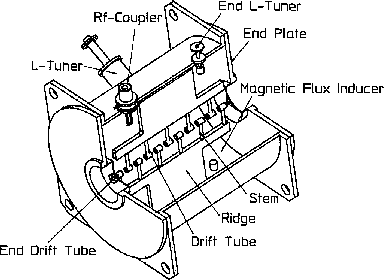
The material of the tank is mild steel, whose inner wall is
plated with copper to a thickness of 100 ![]() m, and that
of the ridges, drift-tubes and stems is oxygen-free copper.
For tuning the cavity, three kinds of tuners are used: a
capacitive tuner (C-tuner), four inductive end tuners
(end L-tuner), and an inductive piston tuner (L-tuner).
The C-tuner is a manually movable disk (19 cm in diam.)
facing a ridge. The L-tuner is moved automatically to
compensate the frequency shift due to the temperature change.
The structure of the 4th tank is illustrated in Fig. 3.
m, and that
of the ridges, drift-tubes and stems is oxygen-free copper.
For tuning the cavity, three kinds of tuners are used: a
capacitive tuner (C-tuner), four inductive end tuners
(end L-tuner), and an inductive piston tuner (L-tuner).
The C-tuner is a manually movable disk (19 cm in diam.)
facing a ridge. The L-tuner is moved automatically to
compensate the frequency shift due to the temperature change.
The structure of the 4th tank is illustrated in Fig. 3.
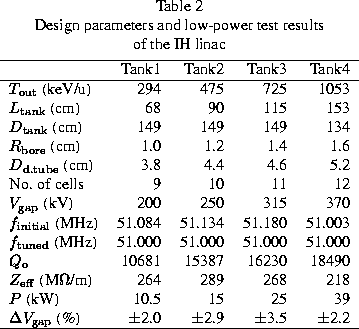
Rf aspects
The results of the low-power tests are summarized in Table 2.
The resonant frequencies ( ![]() ) of four tanks
were tuned with C-tuners to 51 MHz (
) of four tanks
were tuned with C-tuners to 51 MHz ( ![]() ).
Without any particular tuning, we obtained the
gap-voltage distributions almost flat except at the tank ends.
From the measured unloaded Q-values (
).
Without any particular tuning, we obtained the
gap-voltage distributions almost flat except at the tank ends.
From the measured unloaded Q-values ( ![]() ) and field
distributions in the gaps, we figured out effective
shunt impedances (
) and field
distributions in the gaps, we figured out effective
shunt impedances ( ![]() ), and then
the rf powers (P) required for accelerating the
q/A = 1/10 ions up to 1.05 MeV/u.
), and then
the rf powers (P) required for accelerating the
q/A = 1/10 ions up to 1.05 MeV/u.
The capacities of the rf sources for the 1st
through 4th tanks are 12kW, 22kW, 30kW and 50kW, respectively.
The rf sources were connected to the tanks through about
20-m coaxes (WX-77D for the 1st through 3rd
tanks, WX-120D for the 4th tank). Each of the 1st and 2nd
tanks is evacuated by a 500-l/s turbo-molecular pump,
and each of the 3rd and 4th tanks is by a 1500-l/s one.
The obtained vacuum pressures are in the range of 10 ![]() Torr under no power feed.
The high-power aging was conducted for the N
Torr under no power feed.
The high-power aging was conducted for the N ![]() beam acceleration test,
in which 70
beam acceleration test,
in which 70 ![]() of the max. gap voltage was required at
a duty factor of 15
of the max. gap voltage was required at
a duty factor of 15 ![]() . The time spent in aging conducted
at a duty factor of about 20
. The time spent in aging conducted
at a duty factor of about 20 ![]() was about 12 hours per cavity.
was about 12 hours per cavity.
As shown in Fig. 1, the LEBT consists
of a 2.45-GHz ECR ion source, a 90 ![]() bending magnet,
two quadrupole magnets,
and four einzel lenses [4]. The ion source produces
stable nucleus beams.
The bending magnet separates ions with different charge-to-mass
ratios. The quadrupole magnets are used for making the
vertical beam size small in the bending magnet and for matching
the transverse phase spaces at two focal points. The momentum
resolution of the ion separating system is 0.65
bending magnet,
two quadrupole magnets,
and four einzel lenses [4]. The ion source produces
stable nucleus beams.
The bending magnet separates ions with different charge-to-mass
ratios. The quadrupole magnets are used for making the
vertical beam size small in the bending magnet and for matching
the transverse phase spaces at two focal points. The momentum
resolution of the ion separating system is 0.65 ![]() .
A double-slit emittance monitor (EM1) and a Faraday
cup (FC1) are installed at the RFQ entrance.
.
A double-slit emittance monitor (EM1) and a Faraday
cup (FC1) are installed at the RFQ entrance.
The MEBT between the
SCRFQ and the IH linac comprises
a charge stripper (carbon foil of 10 ![]() g/cm
g/cm ![]() ),
a rebuncher and two quadrupole doublets [4].
This transport system has a total length of 3.76 m.
Since the frequency of 25.5 MHz was required for the rebuncher,
a double-coaxial resonator with 6 gaps was developed to
maintain the size small and power low [5].
The emittance monitor (EM2)
is separated into two parts: the front slit is near the RFQ
exit, and the rear one is between the quadrupole magnets.
The Faraday cup FC2 measures the current of drift-through
ions (both of accelerated and unaccelerated ions), and FC3
the current of accelerated ions only. The emittance monitor
(EM3) and the Faraday cup (FC4) were located at the entrance
of the IH linac. The EM3 comprises four moving slits. The
vacuum chamber containing EM3 and FC4 was made compactly so
as to be installed in a small space (38 cm in diam. and
15 cm in length) just before the first tank of the IH linac.
The Faraday cup (FC5) cooled by a water channel
was located at the exit of the IH linac. The momentum
analyzing system in the HEBT was set up at the downstream of
the IH linac. This comprises a quadrupole doublet, a
dipole magnet, a vertical slit with a width of 4 mm and
a charge collecting plate (FC6). This system has a energy resolution
of less than 1
),
a rebuncher and two quadrupole doublets [4].
This transport system has a total length of 3.76 m.
Since the frequency of 25.5 MHz was required for the rebuncher,
a double-coaxial resonator with 6 gaps was developed to
maintain the size small and power low [5].
The emittance monitor (EM2)
is separated into two parts: the front slit is near the RFQ
exit, and the rear one is between the quadrupole magnets.
The Faraday cup FC2 measures the current of drift-through
ions (both of accelerated and unaccelerated ions), and FC3
the current of accelerated ions only. The emittance monitor
(EM3) and the Faraday cup (FC4) were located at the entrance
of the IH linac. The EM3 comprises four moving slits. The
vacuum chamber containing EM3 and FC4 was made compactly so
as to be installed in a small space (38 cm in diam. and
15 cm in length) just before the first tank of the IH linac.
The Faraday cup (FC5) cooled by a water channel
was located at the exit of the IH linac. The momentum
analyzing system in the HEBT was set up at the downstream of
the IH linac. This comprises a quadrupole doublet, a
dipole magnet, a vertical slit with a width of 4 mm and
a charge collecting plate (FC6). This system has a energy resolution
of less than 1 ![]() for the 1-MeV/u ion beam, which has
the design emittance of the IH linac.
The beam energy was estimated from the magnetic field
measured by a hole probe.
for the 1-MeV/u ion beam, which has
the design emittance of the IH linac.
The beam energy was estimated from the magnetic field
measured by a hole probe.
Performance of the SCRFQ
We measured the transmission efficiency as a function
of the intervane voltage. The RFQ operated at 25.47 MHz with
a duty factor of 5%. The N ![]() beam had the input
emittances, 17 and 22
beam had the input
emittances, 17 and 22 ![]() cm
cm ![]() mrad in the x-x' and
y-y' planes, and the current was about
0.22 mA in peak at FC1. The measurement result is
shown in
mrad in the x-x' and
y-y' planes, and the current was about
0.22 mA in peak at FC1. The measurement result is
shown in ![]() 4 along with a simulation.
The horizontal scale is the normalized intervane voltage,
4 along with a simulation.
The horizontal scale is the normalized intervane voltage,
![]() =
= ![]() /50.68 kV. The measured transmission efficiency
of drift-through ions (
/50.68 kV. The measured transmission efficiency
of drift-through ions ( ![]() in the figure) is defined
by I(FC2)/I(FC1), where I(FCi) is the beam current
from the Faraday cup i, and that of accelerated ions
(
in the figure) is defined
by I(FC2)/I(FC1), where I(FCi) is the beam current
from the Faraday cup i, and that of accelerated ions
( ![]() ) by I(FC3)/I(FC1).
The simulation was done by using the
PARMTEQ-H version including
the higher-order-multipole fields calculated by Crandall [6].
At the nominal intervane voltage (
) by I(FC3)/I(FC1).
The simulation was done by using the
PARMTEQ-H version including
the higher-order-multipole fields calculated by Crandall [6].
At the nominal intervane voltage ( ![]() = 1) the
measured transmission efficiency is 90%. This is close to
the designed value of 91.4% with a matched input beam with
= 1) the
measured transmission efficiency is 90%. This is close to
the designed value of 91.4% with a matched input beam with
![]() = 0.06
= 0.06 ![]() cm
cm ![]() mrad. The measured output
emittance profiles were inside of the design ellipses,
with
mrad. The measured output
emittance profiles were inside of the design ellipses,
with ![]() = 0.06
= 0.06 ![]() cm
cm ![]() mrad.
mrad.
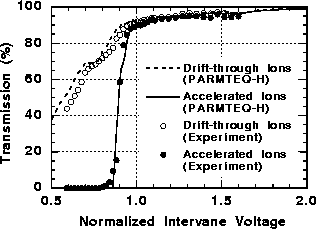
Performance of the linac complex
The overall performance of the SCRFQ/IH linac was
examined by using a N ![]() beam.
The beam intensity at the entrance
of the SCRFQ is about 1
beam.
The beam intensity at the entrance
of the SCRFQ is about 1 ![]() A at peak in a pulse operation,
0.6 ms in width and 100 Hz in repetition rate.
The rf pulse widths of the SCRFQ and IH linac
were set to 1.5 ms so as to cover the beam pulse
from the ion source. The 25.5 MHz-rebuncher was operated
at 100
A at peak in a pulse operation,
0.6 ms in width and 100 Hz in repetition rate.
The rf pulse widths of the SCRFQ and IH linac
were set to 1.5 ms so as to cover the beam pulse
from the ion source. The 25.5 MHz-rebuncher was operated
at 100 ![]() duty.
The beam accelerated by the SCRFQ was directly injected to
the IH linac without using the stripping foil.
Before measuring the beam performance, we adjusted
the gap voltage and rf phase of each IH tank to the
design values, because the output beam energy and its spread
from the IH linac are very sensitive to those parameters.
In Fig. 5, the output energies are
plotted as a function of the rf phase of the tank4;
figure (a) shows a simulation, and figure (b) a measurement.
In the simulation, they were calculated at the design
gap voltage.
duty.
The beam accelerated by the SCRFQ was directly injected to
the IH linac without using the stripping foil.
Before measuring the beam performance, we adjusted
the gap voltage and rf phase of each IH tank to the
design values, because the output beam energy and its spread
from the IH linac are very sensitive to those parameters.
In Fig. 5, the output energies are
plotted as a function of the rf phase of the tank4;
figure (a) shows a simulation, and figure (b) a measurement.
In the simulation, they were calculated at the design
gap voltage.
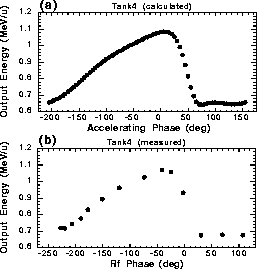
If the beam with a design energy is injected into the tank4, we can adjust the gap voltage and the rf phase experimentally by comparing the measured function with the simulated one. As a result, we set the gap voltage and rf phase to give the nominal output energy. The voltages and phases of the other tanks were also set by the same method as that for tank4.
After adjusting the gap voltage and rf phase, we optimized
parameters of the focusing elements to increase the transmission
efficiency of the IH linac.
Figure 6 shows the beam energy spectra measured at six
operating modes, and figure 7 the transmission efficiencies
of almost 100 ![]() for five operating modes.
For example, "IH-Tank3" in the figure shows
the result obtained when the SCRFQ and the 1st through 3rd IH-tanks
are operated and the 4th tank is not operated.
for five operating modes.
For example, "IH-Tank3" in the figure shows
the result obtained when the SCRFQ and the 1st through 3rd IH-tanks
are operated and the 4th tank is not operated.
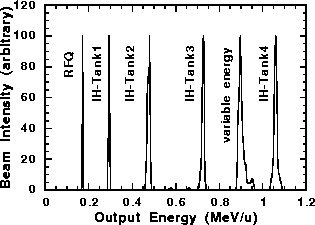
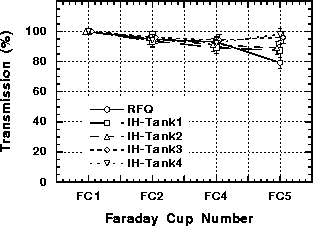
Figure 7: Transmission efficiency for five operating modes.
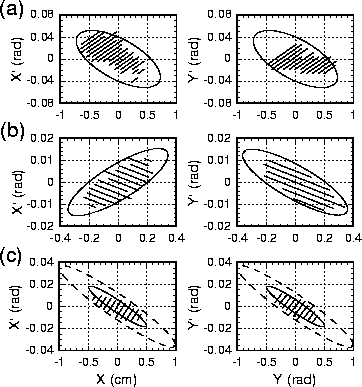
Figure 8: (a) Emittance profiles at the RFQ entrance,
(b) at the RFQ exit, and (c) at the IH-linac entrance.
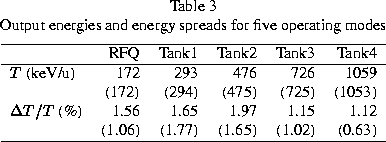
Concluding Remarks
The beam tests of the SCRFQ with a
N ![]() beam showed following results: 1) the
transmission efficiency exceeds 90
beam showed following results: 1) the
transmission efficiency exceeds 90 ![]() at a design voltage,
2) the form of the transmission measured as a function
of the intervane voltage and the emittance profiles of the
output beam agree well with PARMTEQ prediction.
at a design voltage,
2) the form of the transmission measured as a function
of the intervane voltage and the emittance profiles of the
output beam agree well with PARMTEQ prediction.
The beam tests of the SCRFQ/IH linac with
a N ![]() beam showed following results: 1) for five
operating modes, the output beam energy and its spread
agree fairly well with the design values, when the gap
voltage and accelerating phase of each tank of the rebuncher
and IH linac are set to the design values, and
2) the transmission efficiency of the IH linac is nearly 100
beam showed following results: 1) for five
operating modes, the output beam energy and its spread
agree fairly well with the design values, when the gap
voltage and accelerating phase of each tank of the rebuncher
and IH linac are set to the design values, and
2) the transmission efficiency of the IH linac is nearly 100 ![]() ,
when the transverse focusing elements are optimized.
From the beam test results obtained so far, we can say
the performance of the SCRFQ/IH linac is close to the
designed one.
,
when the transverse focusing elements are optimized.
From the beam test results obtained so far, we can say
the performance of the SCRFQ/IH linac is close to the
designed one.
We express our thanks to T. Nomura for his encouragement, M. Imamura, S. Shibata and M. Wada for his help in the work. The SCRFQ and IH linac were fabricated by Sumitomo Heavy Industries, Niihama Work. The rf power sources were fabricated by Denki Kogyo Co., Ltd, and IDX Corporation. The HEBT was constructed by stuff in nuclear physics division at INS. The computer works were done on FACOM M780 and VP2100 in the INS Computer Room.